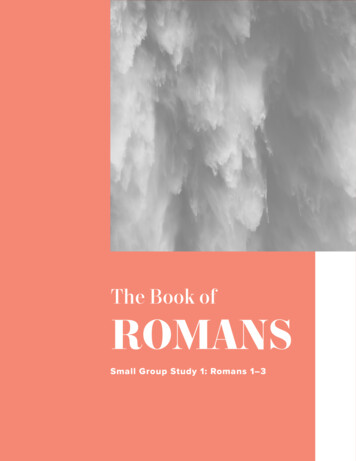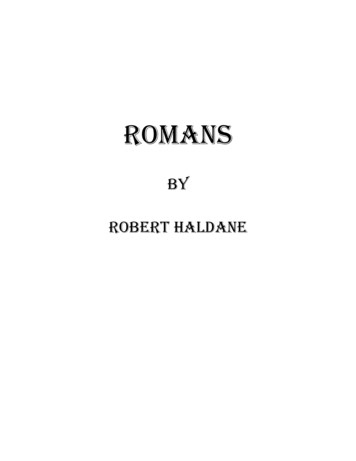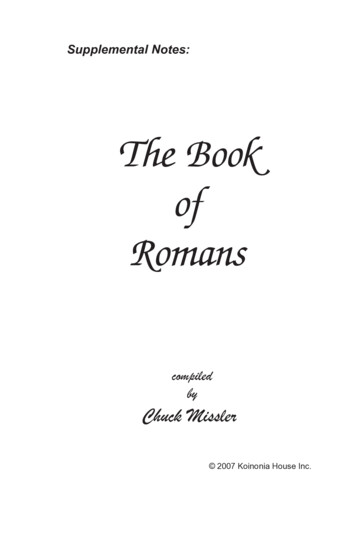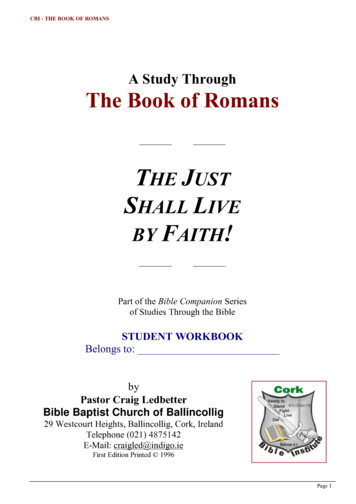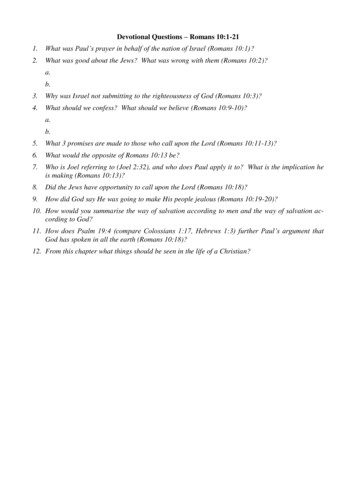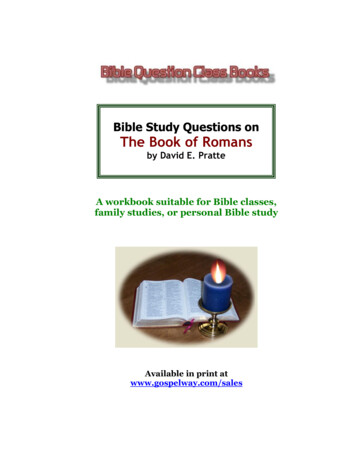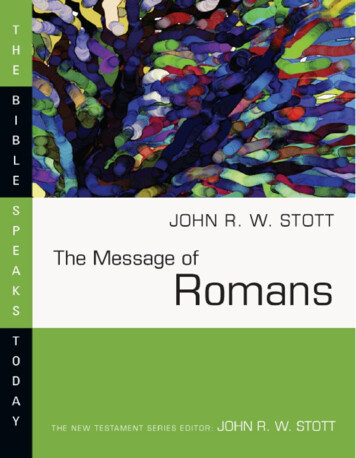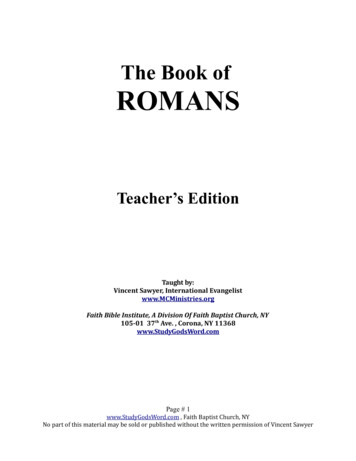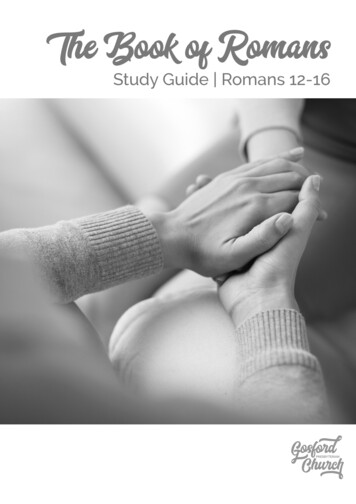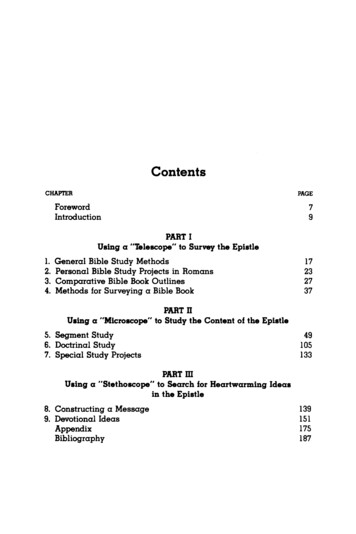
Transcription
ContentsCHAPI'ERPAGEForewordIntroduction79PART IUsing a "Telescope" to Survey the Epistle1.2.3.4.General Bible Study MethodsPersonal Bible Study Projects in RomansComparative Bible Book OutlinesMethods for Surveying a Bible Book17232737PARTDUsing a "Microscope" to Study the Content of the EpistleS. Segment Study6. Doctrinal Study7. Special Study Projects49105133PARTmUsing a "Stethoscope" to Search for Heartwarming Ideasin the Epistle8. Constructing a Message9. Devotional IdeasAppendixBibliography139151175187
1General Bible Study MethodsA serious study of the Bible requires concentration of the mindupon a specific passage. It involves giving careful consideration towords and phrases. The best available tools of biblical scholarshipmust be used in an honest attempt to learn as precisely as possiblewhat the writer intended to communicate in the historical situationwithin which he wrote.INDUCTIVE METHODThe inductive method of Bible study is scientific in approach. It isthe logic of discovery, whereas deduction is the logic of proof. Inductive Bible study involves four processes:1. Observation (What does it say?)2. Interpretation (What does it mean?)3. Application (How does it relate to me?)4. Communication (How do I give it to others?)The inductive method places the emphasis on the process of reasoning or drawing conclusions from particular cases.The Word of God must be given careful attention. It must be interpreted in full harmony with its literal, historical, and grammaticalmeaning. Full attention must be given to the inspired writer's purpose. When the student is face to face with the minute parts ofScripture, he must seek to know the intent of that Scripture in itscontext.Robert A. Traina emphasizes the fact that the student should givespecial attention to the connectives within a passage. The followingtypes of connectives are found in the New Testament:1. Temporal or chronological connective:"After" (Rev. 11:11)17
18Romans: A Model for Bible Study Methods2. Local or geographical connective:"Where" (Heb. 6:20)3. Logical connectives:Reason- "Because" (Rom. 1:25)"For" (Rom. 1:11)Result- "Therefore" (l Cor. 10:12)Contrast - "Nevertheless" (l Cor. 10:5)4. Emphatic connective:"Only" (l Cor. 8:9).2Traina also suggests that special attention be given to the structural relations between paragraphs and sections of the book. Out ofhis more extended list. we have selected five:1. Comparison -the association of like things2. Contrast-the association of opposites3. Repetition - the reiteration of the same terms. phrases. and clauses4. Climax-the arrangement of material in such a way as to progressfrom the lesser to the greater and ultimately to the greatest5. Causation and substantiation -the progression from cause to effectand from effect to cause. 3SYNTHESISSynthesis is the "putting together of a book" or the consideration ofit as a whole. This is the direct opposite of analysis. which attemptsto partition a book into small units of study for the purpose of detailed investigation. With induction. conclusions are drawn on thebasis of detailed observation; in synthesis. general impressions aregained by means of less detailed investigation. and the ramifications of those main ideas are not followed out in detail. 4ANALYSISAnalysis is a detailed study of a book in order to ascertain itsmessage in all its ramifications. It is the direct opposite of synthesis.which attempts to look at the book as a whole and to determine itsmessage in general. In the development of this method. there mustfirst be grammatical analysis. in which a study is made paragraphby paragraph. Determine the principal sentences and note thegrouping around them of subordinate sentences and clauses. andtheir interrelationships. The analytical method begins with a grammatical diagram of the text. followed by a careful outline based onthe diagram. and concludes with various observations on the message set forth.5
General Bible Study Methods19BIOGRAPIDCAL METHODThe biographical method may be studied factually as biographicalnarrative. homiletically as narrative or character exposition. andpolemically or apologetically as biographical argument. In the biographical narrative. the aim is simply to learn the biographical factsconcerning a biblical personality. as those details are revealedeither in a single book or in all of Scripture. Some of the points toconsider in a character's life include: 1) birth and early life; 2) conversion experience and call to a specific task; 3) ministry for the Lord; 4)character evaluation; 5) relationships with others; 6) death and comments about it; and 7) reasons for the inclusion of these facts in thetext. 6THEOLOGICAL METHODThe theological method may be defined as the process of searching through an individual book or the Bible as a whole to collect.compare. and organize doctrinal statements and assumptions. 7DEVOTIONAL METHODThe devotional method may be effectively executed by means of acareful study of words. verses. paragraphs. chapters. books. Biblecharacters. and Christ in a given portion. In a survey course on theBible one should include name. authorship. date. occasion. destination. key verse. literary style. outline and survey of contents. important chapters. special problems. canonicity. interpretation. theChristo logical element. and relationship to other Bible books. 8ADDITIONAL SUGGESTIONSAdditional suggestions are presented by Lawrence Richards. Thisis not Richards's complete list. but it includes items especially helpful in discovering the content of a passage.Readings:1.2.3.4.Read different interpretations of the passage to be studied.Read parallel accounts in Scripture.Read various versions.Read looking for relationships (why? where? when? which? how?).Projects:1.2.3.4.Construct charts and graphs.Diagram a passage of Scripture.Prepare a research paper on a topic.Write up a subject as a newspaper article.
20Romans: A Model for Bible Study MethodsInterviews and Surveys:1. Interview resource individuals on the subject.2. Interview "man on the street" for his opinion.3. Prepare and distribute a questionnaire.4. Make a list of problems people have with this subject. 9In reading a passage one should note carefully every verse thatraises a question in one's mind, tells something about the person ofGod, pictures the thinking and actions of God's people, or seems tohave parallels in modern life.toThe key to profitable Bible study is the addition of application tothe exposition. The student should isolate the key thoughts, summarize those thoughts, and then draw some generalizations as tohow they might apply to daily living.The process of applying discovered biblical truth involves at leastfour steps according to Lawrence Richards in his Creative BibleStudy. 11 First. derive from the passage of Scripture a principle thathas relevance to daily living. The second step is to determine areasof life to which that principle might apply. In the third step one listsareas most relevant to personal needs. The last step sets forth theways in which the applications can be made during the forthcomingweek. Richards lists those steps as generalization, varied application, personalization, and determination.NOTES1. William G. Coltman. The Cathedral of Christian Truth: Studies in Romans (Findlay.Oh.: Fundamental Truth Publishers. 1943). Foreword.2. Robert A. Traina. Methodical Bible Study (New York: Ganis and Harris. 1952).pp.41-43.3. Ibid . pp. 50·52.4. Howard F. Vos. Effective Bible Study (Grand Rapids: Zondervan. 1956). p. 25.5. Ibid . pp. 33-34.6. Ibid . pp. 47-48.7. Ibid . p. 74.8. Ibid . pp. 173. 194.9. Lawrence O. Richards. Creative Bible Teaching (Chicago: Moody. 1970). pp. 244-47.10. Ibid . p. 249.II. Lawrence O. Richards. Creative Bible Study (Grand Rapids: Zondervan. 1979).p. 164.
Probably this epistle should be regarded as the supreme masterpiece of the great apostle. It is a marvel of intellectual acumen, oflogical power, and of spiritual insight. However, it was first intended, not for the philosophers of the Imperial City, not for thesavants of the schools, nor for the circle of Caesar's household,but for the members of an infant Christian church, composedlargely of slaves and freedmen, recently delivered from a degrading heathenism and from the bondage of pagan superstitions.Therefore, in spite of its depth and its difficulties, it has beenbringing light and strength to persons of widely differing degreesof intelligence through all the succeeding centuries. To none hasits guidance been more grateful than to those troubled by theproblems and perplexities of modern thought; for the gospel ofChrist, which it sets forth, is still the sweetest music ever heardupon earth, the most powerful message proclaimed among men,the most precious treasure entrusted to the people of God. 1Charles R. Erdman
2Personal Bible Study Projectsin Romans1. Read Romans at one sitting. If you cannot do this. read chapters1-11. and at another sitting chapters 12-16. Or. read chapters 1-8.then chapters 9-16. In your first reading of Romans be alert tohistorical references and allusions that shed light on the circumstances under which Paul wrote the book. If possible. do yourreading in a translation which you have not used before. or atleast in a translation which employs modern English. An accurate. readable rendering is The New American Standard Bible.published by Moody Press.2. After several overall readings. give an original title to each chapter. using the same criteria as above. These are more difficultbecause now you have to combine more ideas in a few words.3. After several readings of individual chapters. give an originaltitle to each paragraph. Good titles are brief-no more thanthree or four words; memorable-serve as mental hooks to recallthe main idea(s) of the paragraph; and original-the product ofyour own mental mill.4. In Romans 1:1-17. record everything this passage says aboutPaul. Christ. and the gospel.5. Using a concordance. check the references to Rome in this epistle and in the book of Acts.6. In Romans 1:1-32. How is the wrath of God revealed from heaven?Can you find at least four ways? What can we learn about Godfrom nature? Why are the heathen lost? How can God be righteous and allow that?7. Read Romans 1:18-3:20. looking for references to the ideas ofwrath. punishment. and judgment.8. Read Luke's account of Paul's sermon preached in Athens (Acts17:22-31) and the account of the message preached at Lystra (Acts14:15-17). Is there anything in those sermons that is similar to thethought in Romans 1:18-32?23
24Romans: A Model for Bible Study Methods9. From Romans 2:17-3:8:List and explain all the privileges and advantages of havingbeen a Jew.List and explain all of the sins of which the Jews were guilty.List as many life principles as you can derive from this passage. Those are timeless truths applicable to anyone anywhere.10. Name four principles of divine judgment as stated in chapter 2.11. Read Romans 3:21-5:21, watching for recurring words andphrases.12. In 4:1-25, list and explain everything Abraham illustrated aboutjustification-especially of its acquisition and the results of having it.13. Why could not God justify the Jews in one way, and the Gentilesin another way?14. Read Romans 5:1-11. List and explain the benefits of having justification.15. Study every occurrence of the word "life" in Romans 5-8. (Use aconcordance if you wish.) Write out in your own words the essential teaching of each passage.16. What is the ground of the believer's joy according to Romans 5:11?Why?17. Study Romans 5:12-21. Contrast the two Adams, using this passage only. Make a chart of all the differences given here.18. What was the function of law when it was introduced?19. Read Romans 6:1-14. From this entire chapter, list at least tenspiritual truths and how they apply to you personally.20. Explain why objections are raised to justification by faith aloneas opposed to justification by faith and works.21. From Romans 7:7-25, list everything mentioned in the passageabout the old and new natures and their significances.22. What is the main teaching of Romans 7:14-24? Think carefully.23. Read Romans 8:1-39. Chart the work of the Trinity in this chapter.On separate sheets of paper, list everything said about theFather, the Son, and the Holy Spirit and the significance of eachentry.24. Use a concordance to study the New Testament teachings aboutthe Holy Spirit. Where are most of the references to the HolySpirit clustered?25. What is the believer's greatest source of joy and strength in sufferings according to Romans 8:17-27?26. List the references to Israel and define Paul's uses of the term.
Personal Bible Study Projects in Romans2527. From Romans 10:1-21. find as many answers as possible to thefollowing questions:Is there an example to follow (positive example)?Is there an error to avoid (negative example)?Is there a command to be obeyed (my responsibility)?Is there a promise to claim (God's responsibility)?Is there a sin to confess (my responsibility)?28. What is meant by the words, "going about to establish their ownrighteousness" (KJV) in Romans 1O:3? How did Israel attempt this?29. Read Romans 11:1-36. What warnings are given in this chapter?What personal application does each have?30. How does Paul use the word "mercy" in chapters 9, 10, and 11?31. How was the Gentile tempted to boast over Israel? Why should henot do it?32. List the guidelines in chapter 12 for effective ministry in thechurch, and compare them with the spiritual gifts in 1 Corinthians 12 and Ephesians 4.33. What is the outstanding virtue (in your opinion) enjoined uponthe believer in Romans 12?34. From Romans 12:9-21. list as many personal applications ofPaul's admonitions as possible.35. List the fifteen characteristics of God's love found in 1 Corinthians 13:4-7. See if you can find all of them in Romans 12 and 13.36. After studying Romans 13:1-6, What is your opinion of a Christian's going to war for his country?37. In Romans 14:1-15:13, What principles does God give us to makedecisions in those areas where Scripture is not specific?38. Read Romans 16:1-27. Note what is said about each individual.39. Name some characteristics of first-century church life that can begleaned from chapter 16.NOTE1. Charles R. Erdman. The Epistle of Paul to the Romans: An Exposition (Philadel·phia: Westminster. 1925). Foreword.
The Epistle to the Romans is therefore encyclopaedic in its structure; it is round and full, like the circle of Giotto, and contains allthe elements of both natural and revealed religion. The humanmind need not go outside of this Epistle, in order to know allreligious truth. 1William G. T. Shedd
3Comparative Bible Book OutlinesIt is important for a Bible student to develop some proficiency inoutlining Bible content. One or more of the following suggestionsmay prove helpful.The starting point for the outlining process is to read the Biblebook through several times. A short book such as James could beread each day for a month. At the end of that time the main theme ofthe book and several of its logical divisions would have emerged. Instudying a large book such as Acts. the individual might divide thetwenty-eight chapters into seven parts and read each segment of thechapters each day for a week. That would mean spending sevenweeks on that one book. but at the end of that time the theme andsegments would have emerged.A book of the Bible could be outlined by noting the chapter themesand charting them. The Bible as it was originally written had nochapter and verse divisions. But in A.D. 1250 Cardinal Hugot introduced chapter divisions that form fairly satisfactory groupings ofcontent. There are 1.189 chapters in the Bible. The themes of thesixteen chapters in the book of Romans should then be related to thedominant theme of the entire book.There are several types of outlines. Those include. among others.the thematic. geographical. chronological. and biographical. Illustrations of the first three can be seen in How to Search the Scriptures. 2The biographical highlights the outstanding people within a Biblebook. It would be evident through such an outline of the book of Acts.for instance. that Peter had the preeminence in the first half of thebook and that Paul had the preeminence in the latter portion.There are occasions in which a key verse will provide a possibleclue for a Bible book outline. That is evident in some of the outlinesof the book of Revelation. which are based upon the three emphasesin Revelation 1:19.Two additional devices include noting repeated words andphrases. and changes in the type of content. The latter can be illus27
28Romans: A Model for Bible Study Methodstrated in the book of Job, where several messages are inserted in thenarrative text.The four outlines included in this section have unique features.The first one shows the development of a doctrinal theme within thebook. The second also develops a doctrinal theme but adds addi.tional doctrinal emphases. The third outline highlights the majordivisions of the book in terms of major emphases such as doctrinal.dispensational. and practical. The fourth outline emphasizes therhetorical device of alliteration, which is often used in outliningsince it provides assistance in memorizing the content of the outline.Outline showing development of a doctrinal theme within Ro·mans.OUTLINE: BOOK OF ROMANSI. Introduction (1:1.17)A. The Preface of the Epistle (1:1·7)1. The salutation (1:1)2. The signification (1:2·7)B. The Personalities of the Epistle (1:8·13)1. The interest (1:8·10)2. The intent (1:11·13)C. The Purpose of the Epistle (1:14.17)1. The motive (1:14.15)2. The method (1:16·17)II. The Lack of Righteousness (1:18-3:20)A. The Gentile world is proved guilty of sin (1:18-2:16)1. The revelation that God made of Himself (1:18·20)2. The stages of Gentile apostasy from God (1:21.23)3. The results of the Gentile apostasy (1:24·32)4. The principles of divine judgment (2:1·16)B. The Jewish world is guilty of sin (2:17-3:20)1. The law finds the Jewish world guilty of sin (2: 17 ·29)2. The Old Testament Scriptures generally find the Jewishworld guilty of sin (3:1.18)3. The final verdict- The world is guilty of sin before God,hence, the imperative need of righteousness (3:19·20)III. The Provision of Righteousness (3:21·26)A. The righteousness defined (3:22)B. The righteousness attested (3:21)C. The righteousness offered (3:22)
Comparative Bible Book OutlinesIV.V.VI.VII.291. To all2. On faith3. Freely4. By graceD. The ground of righteousness (3:24)E. The purpose of the righteousness (3:26)F. The Author of the righteousness (3:25)The Appropriation of Righteousness (3:27-4:25)A. On faith in Christ (3:27 - 4:4)B. Not of works (4:5-8)C. Not of ordinances (4:9-12)D. Not of law (4:13-23)E. But through the death and resurrection of Christ (4:24-25)The Realization of Righteousness (5: 1- 8: 17)A. Deliverance from condemnation before God through thedeath of Christ (5:1-21)B. Deliverance from indwelling sin (6:1-12)C. Deliverance from the law (6:13-7:25)D. Deliverance from the flesh (or self life) through the HolySpirit who comes from Christ (8:1-17)The Guarantee of Righteousness (8:18-39)A. Creation being kept for the children of God (8:18-25)B. The indwelling of the Holy Spirit (8:26-27)C. The eternal purpose of God (8:28-30)D. The death, resurrection, and exaltation of Christ (8:31-32,34)E. The character of God (8:33)F. The one made righteous before God in the righteousnessprovided in Christ is made eternally safe (8:35-39)The Rejection of Righteousness (9:1-11:36)A. Notwithstanding the covenant blessings (9:1-5)B. Notwithstanding a holy natural descent (9:6-13)C. Notwithstanding the sovereignty of divine mercy (9:14-33)D. The rejection of God's righteousness on the part of the Jews;their own fault 00:1-21)E. But spiritual Israel is finding and receiving the righteousness of God (11:1-6)F. National Israel is judicially blinded and cannot even see therighteousness of God 01:7-12)G. Gentile Christians who have received the righteousness ofGod are warned 01:13-26)H. National Israel notwithstanding their past and present rejection of that righteousness shall in the future be savedthrough that righteousness (11:27-36)
30Romans: A Model for Bible Study MethodsVIII. The Practice of Righteousness (12:1-15:13)A. In Christian duties (12:1-21)1. In Christian consecration (12:1)2. In Christian transformation (12:2)3. In Christian service (12:3-8)4. In Christian fellowship (12:9-16)5. In Christian conduct in relation to those without (12:17-21)B. In civil duties (13:1-7)C. In social duties (13:8-14)D. In fraternal duties (14:1-15:13)IX. Conclusion: Personal Matters (15:14-16:27)A. The apostle's ministry (15:14-22)B. His approaching journey (15:23-33)C. His commendatory note (16:1-16)D. His word of warning (16:17-18)E. His word of praise (16:19)F. His word of promise (16:20a)G. His benediction (16:20b)H. His salutation (16:21-24)I. His ascription of praise (16:25-27)Outline showing doctrinal themes with additional doctrinalemphases.THE EPISTLE OF PAUL TO THE ROMANSIntroduction - sal utationThe author-PaulThe theme-"The gospel of God"The readers - the saints at RomeKey verses-Romans 1:16-17Key word - "righteousness"I. Righteousness Required-condemnationA. The Gentile guiltyB. The Jew guiltyC. Final verdict-a guilty worldII. Righteousness Revealed-salvationA. Redemption in Christ1. Without the law2. By grace3. Through faith4. Without 3:19-203:21-4:253:21-31
Comparative Bible Book OutlinesIII.IV.V.VI.B. Old Testament illustrations of redemption1. Abraham2. DavidRighteousness Received-justificationA. Our heritage in Christ1. Justification2. Peace3. Access4. Glory5. Hope6. Love7. JoyB. Our heritage in Adam1. Sin2. Death3. JudgmentRighteousness Realized - sanctificationA. The believer to reckon himself1. Dead to sin2. Alive to the law3. Alive and yielded to ChristB. The Holy Spirit operates in thelife of the yielded believerRighteousness Rejected-repudiationA. Israel's pastB. Israel's presentC. Israel's futureRighteousness Reproduced - consecration(The will of God for the Christian)The Christian's ResponsibilityA. To GodB. To the body of ChristC. To the worldD. To governmentE. To "the one who is weak in faith"Conclusion - benedictionPraisePaul-the apostle to the GentilesPersonal greetingsBenediction314:1-5, 5:22-16:2316:20, 24-27
32Romans: A Model for Bible Study MethodsOutline showing major divisions in terms of major emphases.ANALYSIS OF ROMANSPrologue (1:1-17)1. Salutation (1:1-7)2. Introduction (1:8-15)3. Proposition 0:16-17)I. DOCTRINAL-PHILOSOPHY OF SALVATION (1:18-8:39)The righteousness of God in relatio to sin and sinsA. The Christian Message (1:18-5:21)(Propitiation and Foundation)Christ for Us-Key: 1:16-171. Theme: Condemnation (1:18-3:20)a. The Gentiles under condemnation (1:18-32)b. The Jews under condemnation (2:1-3:8)c. The world under condemnation (3:9-20)2. Theme: Justification (3:21-5:11)a. The ground of justification-God's grace (3:21-26)b. The means of justification-our faith (3:27-4:25)c. The effects of justification-spiritual fruit (5:1-11)Supplementary (5:12-21)Condemnation and justification traced to their historicalsources in Adam and Christ.B. The Christian Life (6:1-8:39)(Identification and Superstructure)Christ in Us-Key: 5:9-101. Theme: Sanctification (6:1-8:11)a. The principle of holiness (6:1-11)(in death and resurrection with Christ)b. The practice of holiness (6:12-7:6)(in recognition of, and abandonment to, the new relations)c. The preventive of holiness (7:7-25)(in the activity within-of sin and self)d. The power of holiness (8:1-11)(in the unhindered dominion of the Spirit of God)2. Theme: Glorification (8:12-30)a. The evidence of coming glory (12-17)b. The expectation of coming glory (18-27)c. The certainty of coming glory (28-30)Supplementary (8:31-39)
Comparative Bible Book Outlines33From condemnation to glorification; celebrated in atrium·phant song.II. DISPENSATIONAL-PHILOSOPHY OF HISTORY (9:1-11:36)The righteousness of God in relation to the calling of IsraelA. The Election of Israel-past (9:1·29)B. The Rejection of Israel-present (9:30-10:21)C. The Conversion of Israel-future (11:1·32)Doxology (11:33·36)III. PRACTICAL-PHILOSOPHY OF CONDUCT (12:1-16:27)The righteousness of God in relation to everyday lifeA. Paths of Duty (12:1-13:14)1. Religious (12:1.13)2. Social (12:14.21)3. Civil (13:1.14)B. Principles of Action (14:1-15:13)1. Christian liberty (14:1.12)2. Christian love (14:13·23)3. Christian unity (15:1.13)Epilogue (15:14-16:27)1. Purpose and plans (15:14·33)2. Greetings and warning (16:1·24)3. Ascription of praise (16:25·27)Outline uSIng rhetorical device of alliteration.ROMANS: THE THEOLOGY OF THE GoSPELPrologue (1: 1·17)I. The Principles of Christianity (1.8)A. The Question of Sin (1:18-3:20)B. The Question of Salvation (3:21-5:21)C. The Question of Sanctification (6: 1-8:39)II. The Problem of Christianity (9·11)A. God's Past Dealings with Israel (9:1-33)B. God's Present Dealings with Israel (10:1·21)C. God's Promise Dealings with Israel (11:1.36)III. The Practice of Christianity (12·16)A. The Laws of Christian Life (12:1-13:7)1. The spiritual life of the Christian (12:1.13)2. The social life of the Christian (12:14·21)3. The secular life of the Christian (13:1·7)B. The Laws of Christian Love (13:8-16:24)
34Romans: A Model for Bible Study Methods1. Love's conscience (13:8-14)2. Love's considerations (14:1-15:3)3. Love's convictions (15:4-13)4. Love's concern (15:14-33)5. Love's contacts (16:1-16)6. Love's conquests (16:17-20)7. Love's companionships (16:21-24)Epilogue (16:25-27)NOTES1. William G. T. Shedd. A Critical and Doctrinal Commentary of the Epistle of Sf. Paulto the Romans (Minneapolis: Klock & Klock. 1978). Preface.2. Lloyd M. Perry and Robert D. Culver. How to Search the Scriptures (Grand Rapids:Baker. 1967).
Personal Bible Study Projects in Romans 3. Comparative Bible Book Outlines 4. Methods for Surveying a Bible Book PARTD Using a "Microscope" to Study the Content of the Epistle PAGE 7 9 17 23 27 37 S. Segment Study


